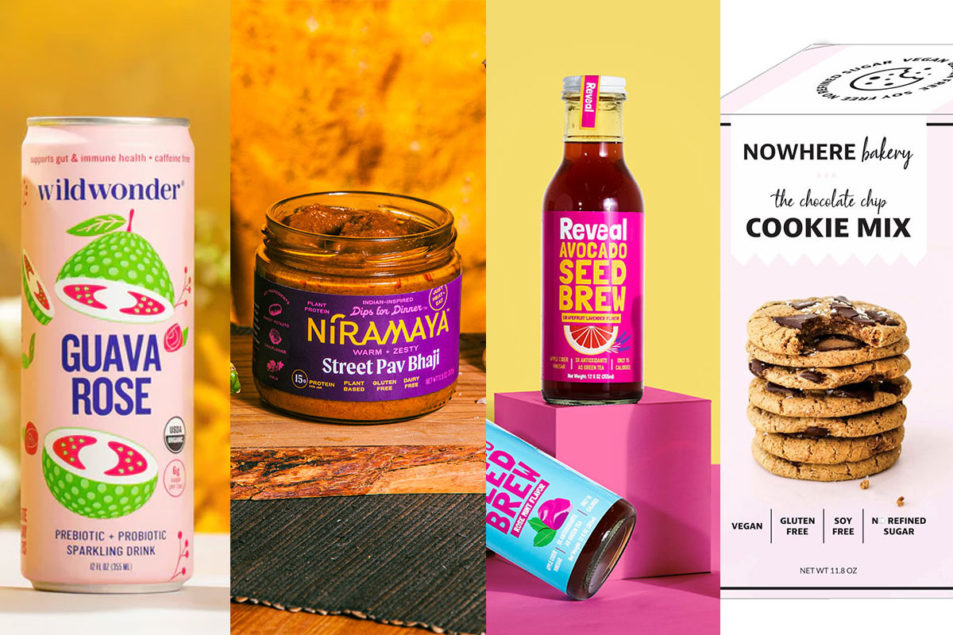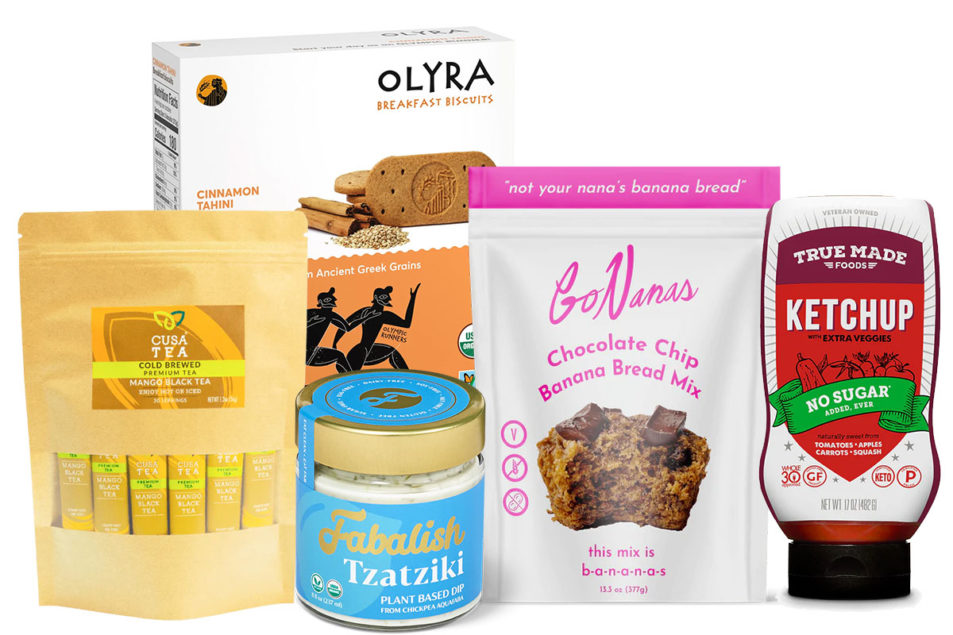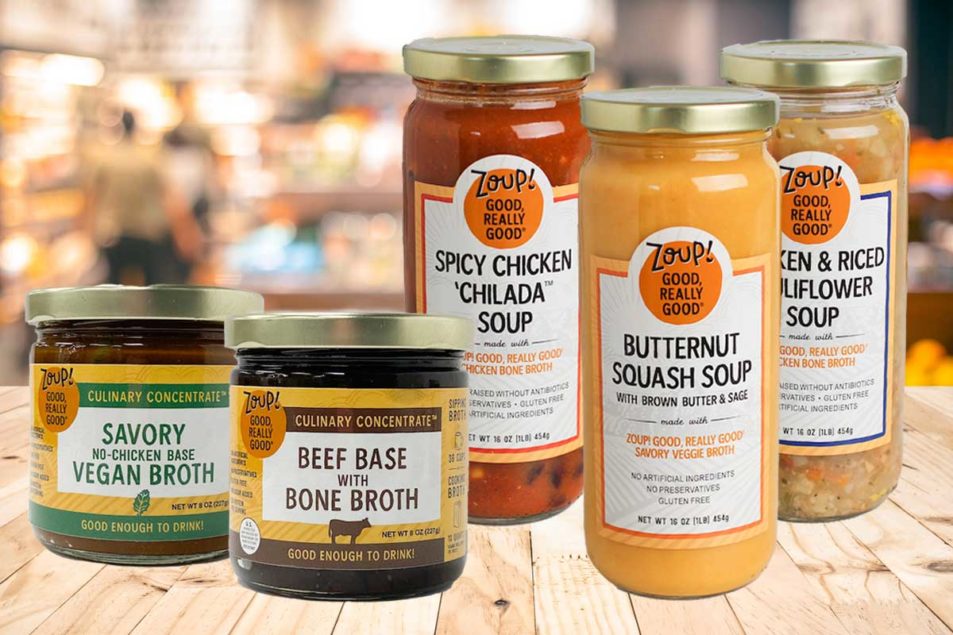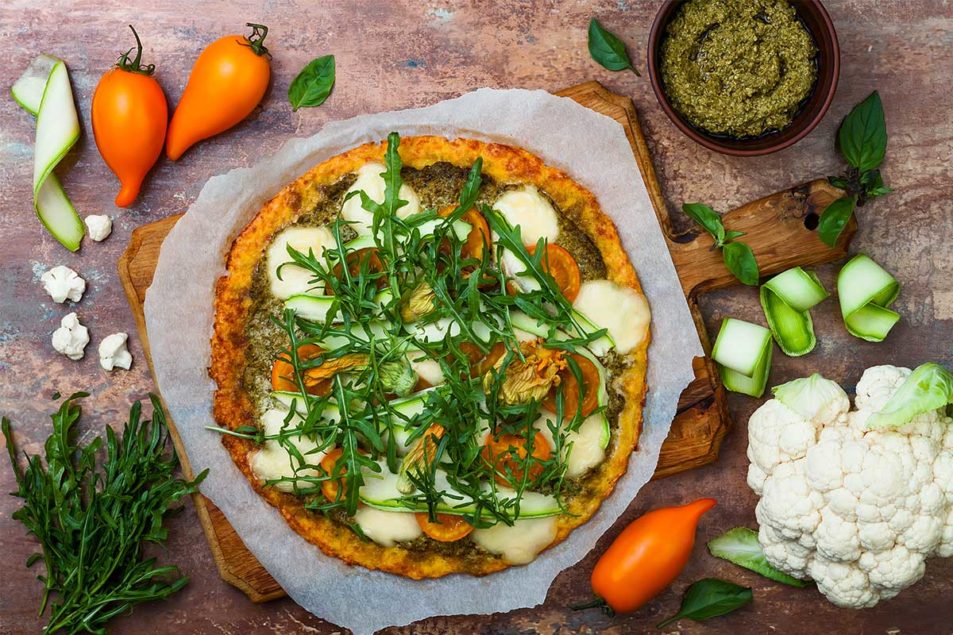SAN FRANCISCO — Fourteen emerging brands were recognized during the second annual Shelfies Awards ceremony, held Sept. 14 and hosted by Startup CPG, an organization dedicated to supporting early-stage entrepreneurs.More than 300 brands submitted over 600 food and beverage products. Forty-one finalists were selected across 13 categories. Products were judged on taste, innovation, mission and branding.Founded in 2019, Startup CPG provides free resources, services and networking opportunities, connecting founders and industry partners at live and virtual events and on digital platforms.“Since our inception, we have been keenly attentive to the unique challenges and opportunities that small emerging CPG brands face,” said Jenna Movsowitz, head of marketing and editor of “The Spotlight” at Startup CPG. “Among these challenges is the cost and labor barrier to nominating products for big-name awards. Yet the recognition of a best-in-class award could be the catalyst to turn an emerging product into a moonshot.”The winners of the 2022 Shelfies Awards are:Best international flavors: Niramaya Foods offers a collection of Indian-inspired, plant-based dips, including masala tomato sabji, super greens saag and street pav bhaji. The versatile dips may be paired with chips as a snack or served with rice and vegetables to create a balanced dinner, according to the company.Best snack: Fun-Gal Snacks is the maker of Popadelics, a brand of crunchy mushroom crisps with culinary-driven flavors, such as rosemary and salt and truffle Parmesan. A portion of sales supports health and wellness causes.Best breakfast food: For Good Granola is a chef-created, no-oat granola based on buckwheat groats, which is rich in vitamins, minerals and protein, plus nuts, seeds, dried fruits and puffed amaranth and sorghum. The startup supports organizations empowering children and adults with disabilities.Best kids’ product: Tiny Sprouts Foods is a children’s nutrition company committed to producing convenient, functional products with organic ingredients and no added sugar, preservatives or artificial flavors. The brand’s core product line features seeds such as chia, flax and hemp, plus probiotics and vitamin D, and may be sprinkled, mixed or baked into a variety of foods.Best baked good: Nowhere Bakery bakes premium cookies, brownies and bars formulated with almond flour, almond butter, organic coconut sugar, organic maple syrup and organic coconut oil. All products are plant-based and free from gluten and soy.Best alcohol beverage: G’s Hard Ginger Beer markets a range of organic, low-alcohol ginger beers that are fermented dry and contain no added sugars, sweeteners or artificial ingredients. The canned cocktails are available in flavors including ginger, lemon and orange; ginger, mint and lime; and ginger, passionfruit, orange and sea salt.Best condiment: AWSM Sauce is pioneering powdered mixes for classic condiments including ketchup, barbecue sauce and hot sauce as a sustainable alternative to conventional bottled options. The brand’s patent-pending ”powder-to-pour” technology helps reduce single-use plastic packaging waste.Best supplement: Two brands tied in the supplement category. Gwella recently launched its Mojo Microdose line of gummies made with a proprietary blend of functional mushrooms, herbs and roots to support energy, focus, clarity and mood. Hone offers a coffee alternative made with matcha and mushrooms to deliver benefits including immunity, energy and focus.Best sustainability-focused product: Hidden Gems has developed a proprietary process to create Reveal Avocado Seed Brew, a ready-to-drink beverage with three times more antioxidants than green tea, plus prebiotics for gut health. Flavors include grapefruit lavender, mango ginger and rose mint.Best plant-based product: Funky Mello’s plant-based marshmallow cremes are formulated with aquafaba, the starchy brine of cooked or canned chickpeas, plus sugar, tapioca syrup, vanilla flavoring and sea salt. The brand is carving out a new category in refrigerated desserts with a versatile fluff that spreads, swirls, melts and more.Best frozen product: Balkan Bites is a maker of frozen appetizers featuring Southeast European comfort foods, such as burek, a savory hand pie with a flaky, phyllo crust.Best beverage innovation: Wildwonder is a beverage brand focused on digestive health. Its low-sugar, sparkling tonics combine prebiotics and probiotics, with flavors ranging from guava rose to peach ginger to strawberry passion.Best branding: Uproot Teas is a direct-trade, premium tea startup, partnering with family farms in Hawaii, Vermont and Kyoto, Japan, to source sustainably grown whole leaf tea.Carl Starkey, co-founder of AWSM Sauce, said the award represents a “major validating step” for the brand.“To start a brand a year ago as two dads with a vision and now be a Shelfie Award winner is wild,” he said.Saphira Rasti, founder and head baker of Nowhere Bakery, added, “It is an honor to be acknowledged for the work we are doing. We have bragging rights.” .
Five emerging brands to participate in Brandjectory Pitch Slam
BATTLE CREEK, MICH. — Five emerging brands were selected to participate in a pitch competition produced by Brandjectory, an online platform dedicated to connecting early-stage consumer products entrepreneurs to investors.The virtual, two-hour event will be held on Sept. 14 and is free to attend. More than $95,000 in cash and services will be awarded, including a $20,000 cash prize for the winner. Co-hosting the event are Jessi Frietag, Startup CPG podcast host and independent consumer packaged goods operations consultant, and Wade Yenny, director of grocery, dairy and frozen at The Fresh Market. An afterparty will feature Jake Karls, co-founder of Mid-Day Squares.The inaugural Brandjectory Pitch Slam finalists are:Cusa Tea & Coffee, a brand of premium instant teas and coffees;Fabalish, a maker of snacks and dips formulated with chickpea ingredients;GoNanas, a producer of allergen-free banana bread mixes;Olyra, a brand of organic breakfast biscuits featuring ancient grains; andTrue Made Foods, a creator of no-sugar condiments sweetened with fruits and vegetables.“These are exceptional founders and business propositions,” said Tom Malengo, co-founder of Brandjectory. “We are excited to offer the first of many pitch slams for the industry. It’s a chance for us to showcase just five of the sensational brands on our platform.”Applications were open to Brandjectory premium subscribers. All applicants received feedback from investors, and the five finalists will receive investor coaching prior to the event, according to Brandjectory. A panel of six investors will determine a winner during the competition.Founded by three industry veterans, Brandjectory provides access to business education, networking opportunities and one-on-one coaching with investors and experts to startup founders seeking seed capital. Since its launch, Brandjectory has facilitated more than 1,400 connections between founders and investors. A year ago, Brandjectory added the premium membership service with benefits including invitations to all Brandjectory events and meet-ups; participation in coaching and mentoring with investors, buyers, brand marketers, product segment experts and more; a founder-only discussion forum; access to hundreds of articles from experts and partners; and brand exposure to a community of hundreds of investors.Startup founders may learn more or register for a premium membership at brandjectorynow.com. Attendees may register for the Brandjectory Pitch Slam at bit.ly/3QfVNFL. .
Inside Zoup’s growing retail lineup
FARMINGTON, HILLS, MICH. — A downward turn in soup sales inspired Zoup! Specialty Products to expand its retail lineup. Known for broths that are “good enough to drink,” the brand earlier this year debuted a line of shelf stable premium soups featuring five chef-inspired recipes.Kettle-cooked in small batches, the soups are free from gluten, artificial ingredients and preservatives and feature the brand’s homestyle broths as their base. Varieties include chicken and riced cauliflower, butternut squash with brown butter and sage, spicy chicken chilada, tomato bisque and garden vegetable.Sales of ready-to-eat soup fell 9% at retail in 2021, according to data from IRI, a Chicago-based market research firm. Negative perceptions of canned food were a factor, with many shoppers seeking options perceived as healthier, fresher and trendier.“We know soup, and we know the soup category shouldn’t be declining,” said Eric Ersher, founder of Zoup! Specialty Products and Zoup! Eatery. “We began operating on the thesis that people wanted high quality soups, but it simply wasn’t available; and people wanted to eat soup, but they didn’t want to eat foods out of cans.”The launch marked a “return to roots” for the brand, which got its start as a fast-casual restaurant chain. WOWorks, parent company of Saladworks and other foodservice brands, acquired Zoup! Eatery in May. Zoup! Specialty Products continues to operate as an independent business led by Mr. Ersher.It has been nine years since he brought the brand into retail. More than two decades of experience gave him a firm grasp of what makes a good broth, but none of the options available in grocery stores delivered the complex balance and taste served on Zoup! Eatery menus. Mr. Ersher leveraged the restaurant franchise business to fund the new venture, investing $500,000 and several years of research to develop a line of shelf stable broths worthy of the Zoup! moniker.The brand was the first-to-market in the premium broth category and the first broth to be packaged in recyclable glass jars, he said. “The category has evolved quite a bit since then,” Mr. Ersher said. “When we first came to market, we faced objections from buyers because we were in glass and because we were more expensive than other products out there. It seemed as if there was only a choice between cans or aseptic cartons, and 32-oz of bone broth only cost a few dollars.”A wider variety of products at a range of price points populate the broth aisle today. Mr. Ersher said Zoup! is positioned as the category’s “highly accessible premium line.”The company is gearing up to introduce its third line, a trio of clean label Culinary Concentrates, this fall. The “super clean label” broth concentrates come in beef bone broth, chicken bone broth and savory no-chicken vegan broth varieties.“This new product is intended to be a challenger to the existing broth concentrates, so we side-by-side in blind taste tests,” Mr. Ersher said. “It’s a little bit more expensive, but it goes a long way. A little 8-oz jar will produce gallons of broth.” .
Gluten-free offers many opportunities for specialty bakers
While no longer at early pandemic levels, bread sales remain strong, thanks in part to increased consumer demand for specialty offerings. Center-store dollar sales of specialty bread rose 2% to $27.6 million, according to IRI for the 52 weeks ending April 17, 2022. Sales of panini, ciabatta and focaccia bread jumped 23.1% to $24.7 million. Shoppers are prioritizing indulgence when it comes to their baked foods, and inflation has driven many to opt for their favorite premium brands instead of eating out. At the same time, increasingly health-conscious buyers have driven sales of better-for-you (BFY) breads, including gluten-free offerings, and bakeries that specialize in these products are taking advantage. Canyon Bakehouse, Johnstown, Colo., for example, recently launched a gluten-free brioche dinner roll in addition to its line of whole grain, gluten-free products. And tortilla makers like Mission Foods, Irving, Texas, and Siete Family Foods, Austin, Texas, offer gluten-free tortillas made from almond, cauliflower, chickpea and cassava flour. It’s clear that products that marry consumer demand for premium and gluten-free baked goods can find success. But reformulating these offerings can be challenging for bakers, requiring them to do their homework on their desired product qualities and the best combination of gluten-free solutions to get the job done.Replacing the irreplaceable Baked foods rely on gluten to provide the expected texture, volume and more in consumers’ favorite baked foods. And that’s no different with specialty breads. “When it comes to gluten, I think we’ve got to be fair that you’re replacing an incredible ingredient,” said Steven Gumeny, regional product manager at Beneo. “Consumers expect certain textures from different types of bread, and really those classic textures are rooted in the tradition of working with wheat flour. The elasticity and structure provided by gluten, it’s naturally unique, and it’s very hard to replace in the bakery.”This elasticity allows bakers to easily form dough into what will become a premium roll, loaf or flatbread. Gluten also provides volume during baking, an essential function often lost when gluten is removed. “The most challenging thing for gluten-free bread is we often get the big holes inside a loaf,” explained Yanling Yin, PhD, director, bakery application, Corbion. “It’s because it doesn’t have gluten that provides visco-elasticity and can retain air bubbles without collapsing when the loaf is done expanding in the oven during baking.”Removing gluten can be especially difficult in premium products, Mr. Gumeny noted, because there’s more variance in the bubble formation and crumb structure, which significantly impacts texture. Understanding this expected texture is critical for bakers.“In a specialty product, the challenge is first to think about what that desired texture will be,” he said. “Is your tortilla going to be flexible or is it going to be crisp? Does your flatbread need crunch or chewiness, or both? And what’s your desired crust structure; are you going for a more rustic, bread-like crumb, or do you want the finer, cake-like features?”Once bakers decide on texture, they can then understand what may happen to it if gluten is removed. “For example, gluten-free flatbread is prone to tearing because of limited strength or elasticity, and it may have a powdery mouthfeel compared to traditional flatbreads,” explained Hanna Santoro, senior bakery scientist at ADM. “Freeze-thaw instability can affect textures of gluten-free pizza crusts or focaccia breads. Additionally, ancient grains might present a bitter aftertaste or aromatic off notes.”Replacing gluten is a difficult task in any premium product, but it may be easier in applications like tortillas that are less reliant on gluten for structure, noted McKenna Mills, senior technical services specialist for bakery, Cargill. “Formulating a gluten-free tortilla may be a little easier — you won’t need gluten’s strength to hold the product up. Still, you’ll face texture and mouthfeel challenges,” she said. “Gluten provides a chewiness and resiliency that is hard to replicate with other ingredients. Remove the gluten, and you’ll encounter negative attributes like gumminess, which can be difficult to eliminate.”Gluten also provides the moisture that is essential for achieving the proper texture of tortillas and flatbreads. “[Gluten-free] is a challenge in the flatter breads — the tortillas and flatbreads — because you don’t want these products to dry out, and if they do, they just become crackers,” Mr. Gumeny said. “So keeping that moisture without having all that great dough structure inside to trap the moisture, that becomes important.”Starch support In gluten-free formulations, starch is a go-to for bakers to hold onto that moisture, as well as maintain other key functionalities.“For structure, we typically rely on starches, which can serve as the backbone of the dough,” Ms. Mills said. Rice starches, for example, can mimic the structural and moisture-retaining capabilities of gluten in many applications. This includes waxy rice starch, which is made almost entirely of amylopectin, a compound that provides a unique branching structure that helps prevent gluten-free products from degrading.“This starch swells as soon as it’s mixed with the wet ingredients, which really improves your dough handling up front, and it’s also trapping in the moisture and keeping it where it belongs: in the bread during the baking process and also throughout the shelf life,” Mr. Gumeny explained. “That waxy instant starch is a great one for gluten-free products, pretty much all of them, and that same starch can be used to reduce breakage even in hard-baked goods like crackers and shortbreads as well.” Another key ingredient is starch or flour made from indica rice. This rice is high in the compound amylose, which aids in the crumb structure and formation of bubbles in the bread during baking. Bakers that use these waxy and indica rice solutions in conjunction can get the moisture retention and dough workability needed in baked foods. Beneo’s Remyline includes a finely ground, instant starch made from waxy rice. The company also offers a coarse, native indica rice starch and wet-milled micronized rice, both of which can be used together with instant waxy starch. The use of rice ingredients can also help specialty products achieve a clean label, which is increasingly popular with consumers. Cargill released its SimPure soluble rice flour earlier this year as a label-friendly alternative to maltodextrin, a processed ingredient derived from starch used to provide bulk, viscosity and taste to baked foods. “With our soluble rice flour solution, product developers finally have an alternative that behaves very similarly to maltodextrin in terms of functional attributes, and at the same time, it aligns with today’s consumer trend toward familiar ingredients,” Ms. Mills explained. Other starches and flour sources can serve as the backbone of specialty gluten-free formulations as well, including potato, tapioca, almond and cauliflower. Cargill’s SimPure potato and tapioca starches can fill the functional role of gluten while also satisfying consumers’ label expectations.Sorghum and oat flours are also commonly used due to their more neutral flavor profile compared to other alternative grains available, explained Vanessa Brovelli, research and development director at Bay State Milling. “In addition, their whole-grain nutritional contributions can boost fiber and protein, which is typically lacking in gluten-free baked goods made with mostly starches or white rice,” she added.Bay State Milling’s SowNaked Oats contain 40% more protein and half the carbon footprint of traditional oats, making them an ideal gluten-free option for specialty bakers looking to add additional nutritional and environmental benefits to their products.Regardless of the options bakers go for, Mr. Gumeny noted it’s important they nail down the right combination and quantity of each ingredient for their specific premium application, as well how the solution will interact with the other ingredients in the formulation.For example, cauliflower flour, a popular gluten-free substitute in pizza crusts and tortillas, often has a higher moisture content than conventional flour.“What that means is you either need to adjust how much moisture you add to your dough and be aware that these ingredients like starches, which are going to be trapping that moisture, are going to interact with that additional water activity as well,” Mr. Gumeny said. “So keeping in mind when adding a cauliflower, for example, that it’s not going to be a one-to-one with bread flour in terms of moisture.”Tortillas and flatbreads also typically have a much higher fat content than traditional breads, and this ingredient will affect how quickly starch absorbs moisture. “You need to be aware of that and possibly adjust your starch level up or down depending on the overall water activity of your product, based on the amount of shortening that you’re using,” he added.To eliminate some of the formulating complexity, Corbion offers gluten-free bread and tortilla bases. “Bases mean customers just add water and some yeast. Bakeries don’t have to batch in all those minor functional ingredients,” Dr. Yin explained. “The bases improve bakery production efficiency by reducing batching errors. It’s one of the popular solutions for bakeries.” Maintaining shelf life is another vital component when choosing the right ingredients. For example, gluten-free baked foods headed for the freezer aisle may benefit from more waxy starch that’s designed to resist retrogradation. “If you make sure there’s waxy rice in a frozen baked good, you’re actually going to get some good freeze-thaw stability on that, which means less ice crystals and ultimately a better product for longer,” Mr. Gumeny said. Makers of gluten-free flatbreads or pizza crusts also need to consider how the process affects gluten-free ingredients. “If you’re trying to sheet out thin pizza crust compared to rising a loaf of bread, some things are different,” he noted. “You’re still going to want good dough spring, you’re still going to want good structure, but you’ve got to be aware of again how your process interacts with the ingredients, namely in our case the starch, because anytime you have other ingredients that are competing for moisture, or you have a process that could potentially be damaging some starch, you could see differences.”Gums, emulsifiers and more While starches are a go-to for structure and moisture retention in gluten-free applications, bakers often include other ingredients to further replicate gluten’s functionality. This includes gums, which are often used as gelling agents to impart the proper texture of specialty breads. “Some starches can help with gel strength, but we’ll often turn to hydrocolloids like xanthan gum, guar gum and/or locust bean gum to deliver the full functionality needed,” Ms. Mills said. “These ingredients help provide proper batter viscosity, air entrapment, crumb elasticity and stability.”Setting agents can also assist with shelf life by extending crumb softening and preventing starch retrogradation, she added. Bean and pulse powders, including fava, pea, chickpea, navy beans and red lentils, can fill this role in gluten-free products while providing an additional source of protein, Ms. Santoro noted. Emulsifiers will often be added as well to help maintain softness. “Release agents like our soy, sunflower or canola lecithins are key for machinability,” Ms. Mills said. “Without any flour to hold onto the water, most gluten-free doughs are extremely sticky. Release agents improve the processability of gluten-free doughs.”Another common issue with gluten-free products is a dry texture, which can be solved with humectants that improve moisture retention over the product’s shelf life, as well as freeze-thaw stability, Ms. Santoro added.“Sweetening solutions are another solve,” she said. “Products like our reduced sugar glucose syrup aid in moisture retention while reducing total sugars in the formulation. Additionally, allulose syrup reduces sugars as well as total carbohydrates to help gluten-free bakery achieve lower carb claims.”Bakers can also extend the shelf life of gluten-free premium products through enzymes. Corbion offers its Ultrafresh line of enzymes for breads, buns, bagels, tortillas and flatbreads, as well as natural mold inhibitors. Growing consumer demand for BFY and premium offerings present an opportunity for bakers looking to make gluten-free specialty breads, but formulating these products remains a steep order. There’s no single drop-in option to replace the functionality of gluten, and bakers should work closely with suppliers to find the right ingredients for their desired product. .
Brandjectory launches first-ever pitch competition
BATTLE CREEK, MICH. — Brandjectory, an online platform dedicated to connecting early-stage consumer products entrepreneurs to investors, is hosting an inaugural pitch competition. The virtual, two-hour event will be held on Sept. 14 and is free to attend.Founded by three industry veterans, Brandjectory provides access to business education, networking opportunities and one-on-one coaching with investors and experts to startup founders seeking seed capital. Since its launch, Brandjectory has facilitated more than 1,300 connections between founders and investors.The pitch slam is open to Brandjectory premium subscribers, and applications will be accepted through Aug. 15 at brandjectory.eb-sites.com/PitchSlam2022. All applicants will receive feedback from investors. Five finalists will receive investor coaching prior to the event, and the winner will be awarded a cash prize, plus additional prizes.“Everything we do at Brandjectory is designed to help CPG founders navigate the fundraising process and become comfortable communicating and working with investors,” said Michael Movitz, co-founder of Brandjectory. “While we provide a great deal of business education, our ultimate goal is to help founders clearly understand what investors are thinking, what they are looking for, and what they want to hear to know that a brand founder has built an investor-ready business. That is why we want to make sure all applicants get investor feedback, even if they are not a finalist.”Additional perks of a premium membership include invitations to all Brandjectory events and meet-ups; participation in coaching and mentoring with investors, buyers, brand marketers, product segment experts and more; a founder-only discussion forum; access to hundreds of articles from experts and partners; and brand exposure to a community of more than 500 investors.“The Pitch Slam is just one more opportunity to provide value to our Premium members,” said Susan Bryenton, co-founder of Brandjectory. “We are constantly adding features, speakers, events, new discussion topics and many more opportunities for CPG founders to learn and interact with CPG investors and industry experts. We are pleased to know the process is working. Not only are founders and investors connecting and continuing the conversation, we are learning of funding that is beginning to occur.”Startup founders may learn more or register for a premium membership at brandjectorynow.com. .










